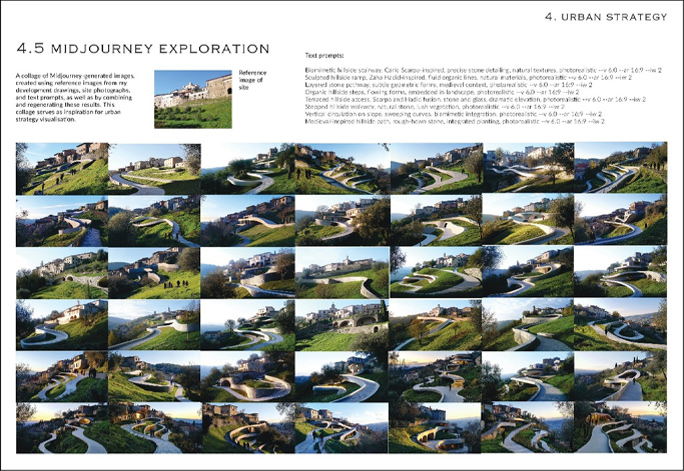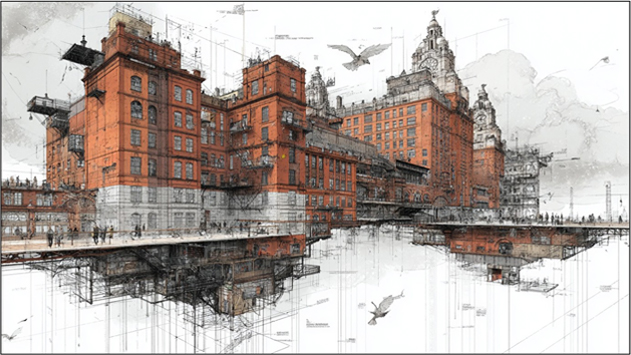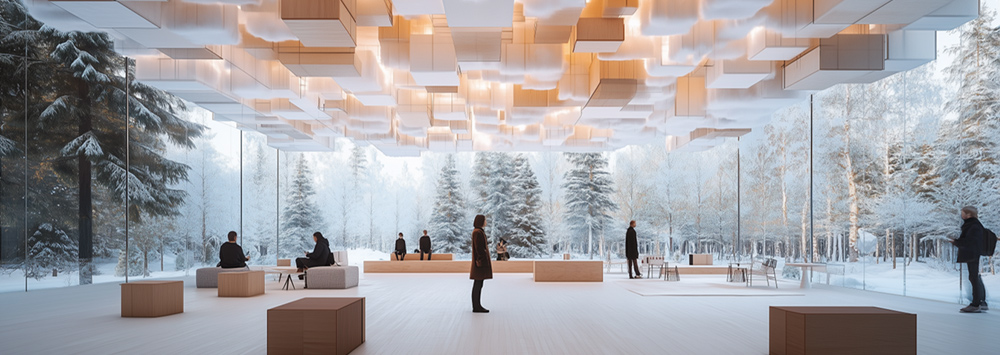This project introduced students to the creative potential of generative AI through a series of design-focused challenges embedded within architectural education. By experimenting with emerging text-to-image tools, students developed greater confidence in using new technologies while sharpening their conceptual thinking and visual communication skills. The emphasis on exploration, authorship, and ethical awareness encouraged students to take risks and reflect critically on their design process—skills that are increasingly relevant in contemporary architectural practice. The initiative has been particularly well received by students, who described it as both inspiring and empowering in helping them push the boundaries of their creative work.
Please briefly describe the activity undertaken for the case study
This project introduced generative artificial intelligence (GenAI) into architectural pedagogy through a structured, research-driven programme centred on creativity and digital fluency. Conducted during the Liverpool School of Architecture Winter School 2025, the initiative comprised a series of workshops and a GenAI drawing competition designed to explore the impact of text-to-image generative models on students’ conceptual development.
Traditionally, architecture students at undergraduate level develop early-stage design ideas through sketching, physical model-making, and the use of 2D/3D digital drafting software such as AutoCAD, SketchUp, and Rhino. These methods rely heavily on the students’ own ability to visualise and iterate spatial ideas through either manual or parametrically controlled processes. However, they often struggle to quickly explore multiple spatial scenarios or atmospheric qualities in early stages of design, particularly when time or technical skill becomes a limiting factor. The introduction of GenAI shifted this paradigm by enabling students to rapidly generate and reflect upon a wide range of speculative visual outputs, responding to custom-written text prompts.
The focus of the exploration was to understand how GenAI could act as a catalyst for creative thinking—particularly during the early stages of architectural design—by enabling students to generate atmospheric, spatial, and material ideas through prompt-based image generation. Students were introduced to text-to-image diffusion model tools such as Midjourney and Adobe Firefly and challenged to carry out creativity tasks. The broader goal was to support creative exploration while embedding emerging GenAI literacy into the curriculum in line with the Liverpool Learning Framework.
How was the activity implemented?
The project followed a four-stage structure:
- Workshop and AI Tasks – Students attended training sessions on generative AI tools, particularly Adobe Firefly and Midjourney. They learned to write effective text prompts and explored how AI can assist conceptual and compositional thinking in architecture (Figure 1a and 1b)
- AI Drawing Competition – Each student submitted AI-generated images for each of the three challenges programmed. Prompts were crafted with semantic range in mind, promoting creativity through unexpected associations (Figure 1c)
- Assessment of Creativity – At the end, students evaluated the generative tool using the Creativity Support Index (CSI), a recognised metric in the literature.
- Dissemination – The project culminated in an exhibition and the preparation of academic outputs including journal articles, a book chapter, and a forthcoming conference presentation.
As part of the funded project, students were provided with access to AI platforms and had the flexibility to use either university devices or their own laptops for prompt-based image generation. Feedback was embedded at various stages, including post-competition reflections and peer discussion.


Figure 1. Panels a and b: AI skill-building workshop and an AI drawing competition intended to foster responsible and ethical engagement with generative AI. Panel c presents a selection of student submissions, illustrating the creative outcomes achieved through transparent and critically informed use of AI tools.
Has this activity improved programme provision and student experience, if so, how?
Yes—this activity had a direct and immediate impact on student learning by empowering participants to engage creatively and critically with emerging technologies. Students reported feeling liberated by the open-ended nature of prompt-based image generation, which enabled them to explore speculative ideas and spatial narratives in ways that traditional sketching or CAD tools may not easily support. The process fostered digital confidence, enhanced conceptual experimentation, and supported a stronger sense of design authorship.
To formally evaluate feedback, we used the CSI, a recognised survey tool designed to measure how well a system or process supports creativity from the perspective of the user. The CSI gathers student responses across multiple dimensions—such as exploration, collaboration, enjoyment, and results worth effort—and converts them into a single score out of 100. The GenAI tools received an overall CSI score of 81, indicating a high level of perceived creativity support from the students’ point of view.
A particularly compelling outcome was observed in one undergraduate student who applied the techniques and conceptual thinking developed during the AI competition to a formal coursework submission. This not only demonstrated the practical transfer of skills but also set a precedent for how generative AI can be integrated ethically and meaningfully into academic work. By acknowledging the role of AI while retaining critical design authorship, the student exemplified academic integrity in the context of emerging tools, a valuable and timely model for others (see Figure 2).
Building on this success, the initiative has catalysed broader curriculum change. Originally conceived as a standalone activity within the Liverpool School of Architecture Winter School, the AI drawing competition has since served as a foundation for the formal inclusion of generative AI in the undergraduate curriculum—a pioneering move at this level. As a result, the school is now positioned at the forefront of digital fluency and creative experimentation in architectural education.

Figure 2. Example of academic integrity in architectural design coursework. “Midjourney exploration with full disclosure demonstrates transparent authorship: the student documents image seed, prompts, and parameters that are recorded alongside the evolving design to evidence authorship and critical judgment” (Image courtesy of Louis Shepley, third year BA Architecture student at the University of Liverpool 2024-256)
The impact of the project also extended into academic practice. Insights developed during the delivery of the student competition directly informed an AI-generated entry submitted by the principal investigator to the Royal Institute of British Architects (RIBA) Journal Eye Line 2025 drawing competition, where the work was longlisted. This outcome not only reinforced the creative value of the techniques explored in the project but also exemplified how generative AI can support conceptually rich and visually compelling design work when guided by architectural thinking and careful prompt engineering. The image, shown in Figure 3, presents a speculative and dystopian tribute to the city of Liverpool—envisioning a skyborne twin that is unfinished, unpolished, and emotionally resonant. Through a composition that deliberately resists closure, the work seeks to embody the city’s texture, memory, and soul.

Figure 3. AI-generated image longlisted in the RIBA Journal Eye Line 2025 competition. Created by the principal investigator using Midjourney, the work applies creative strategies developed through this project’s exploration of generative AI in architectural design.
Did you experience any challenges in implementation, if so, how did you overcome these?
A key challenge was ensuring students had the necessary AI literacy to generate meaningful outputs. To address this, the project began with a dedicated workshop and included iterative support throughout. Another difficulty lay in managing tool access, as some AI platforms required subscriptions.
A significant challenge we faced was evaluating creativity in a way that was both meaningful and rigorous. Creativity is a complex and subjective concept, particularly in architectural education, where students are encouraged to develop highly individual responses to design problems. To address this, we adopted a mixed-methods approach that combined both quantitative and qualitative evaluation. Quantitatively, we used the CSI which is a structured questionnaire that asks students to rate their experience across areas like how much the activity encouraged idea generation, exploration, collaboration, and whether the results were worth the effort. Qualitatively, we gathered written student reflections and conducted visual analysis of the AI-generated images, looking for evidence of originality, complexity, and depth in how students interpreted the design brief. This helped us assess not just the technical output, but also the conceptual engagement behind each submission.
Another important challenge was framing AI as a creative partner rather than a shortcut. Students needed to understand that while generative AI can produce visually striking images, its true educational value lies in how they guide, interpret, and critique the outcomes. To support this, the workshops placed strong emphasis on authorship and reflective discussion, encouraging students to remain critically engaged throughout the process.
How does this case study relate to the Hallmarks and Attributes you have selected?
This project closely aligns with the Liverpool Hallmarks of active learning, digital fluency, authentic assessment, and confidence. Students actively engaged with AI tools in real time, crafted bespoke visual outputs, and reflected on their design choices through feedback and peer comparison.
Authentic assessment was a central tenet: the AI-generated drawings served both as creative artefacts and as reflections of students’ conceptual thinking. The activity supported future-facing skills increasingly relevant in architectural practice, particularly the ability to integrate emerging technologies critically and creatively.
The project also foregrounded the importance of visual storytelling, aesthetics, and ambiguity—skills that align closely with architectural judgment and speculative thinking. In this sense, the use of generative AI was not only a technological integration but also a pedagogical statement about the evolving nature of design authorship.
How could this case study be transferred to other disciplines?
This case study has strong cross-disciplinary potential. Generative AI can be adapted for visual ideation in art and design, speculative storytelling in humanities, conceptual modelling in product design, or data-driven visualisations in environmental science.
The CSI methodology and visual analysis techniques can also be reused in disciplines interested in evaluating student creativity or engagement. More broadly, the framework encourages critical dialogue around digital fluency, authorship, and ethical AI use which are topics with growing relevance across higher education.
If someone else were to implement the activity within your case study what advice would you give them?
Start small with a focused pilot. Prioritise one or two accessible AI tools and provide scaffolded support to help students write meaningful prompts. Position the activity within a broader pedagogical narrative (creativity, reflection, authorship) rather than just novelty or aesthetics.
Ensure students understand AI as a tool that can extend, but not replace, their design agency. Build in opportunities for formative feedback and collective discussion to deepen critical engagement. Use competition or exhibition formats to elevate student work and enhance motivation.
Finally, build in robust evaluative methods, such as established creativity assessment frameworks (e.g., the Torrance Tests of Creative Thinking, Amabile’s Componential Model of Creativity, or the Consensual Assessment Technique) as well as tools like sentiment analysis and structured peer review, to gather meaningful insights into the impact of the intervention. These approaches can help capture both the cognitive and affective dimensions of creativity and student engagement. Importantly, they provide a strong foundation for generating research outputs while also informing the continuous enhancement of teaching practice through evidence-based reflection and refinement.

Exploring AI-Driven Creativity in Architectural Pedagogy through an AI Drawing Competition by Dr Carlos Medel-Vera, Ms Sandy Britton and Dr (c) William Gates is licensed under a Creative Commons Attribution-NonCommercial 4.0 International License.
